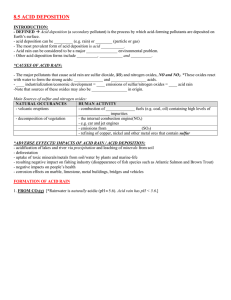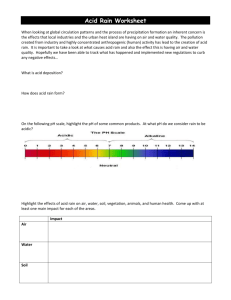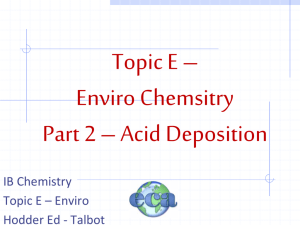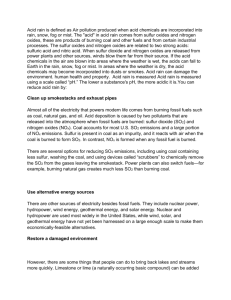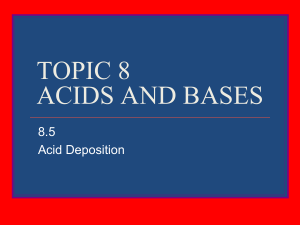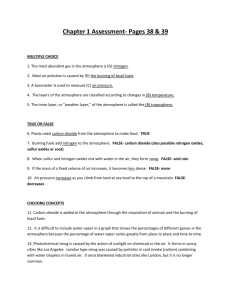Group 2 Biology35ProjectStudyNotes Acid Deposition
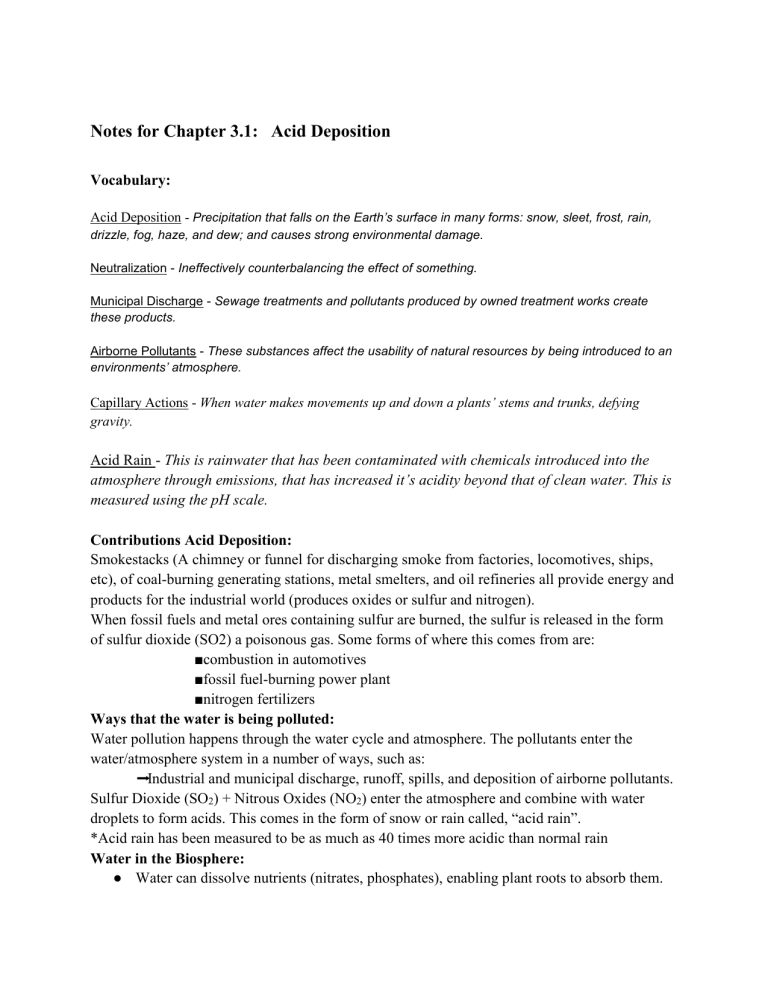
Notes for Chapter 3.1: Acid Deposition
Vocabulary:
Acid Deposition - Precipitation that falls on the Earth’s surface in many forms: snow, sleet, frost, rain, drizzle, fog, haze, and dew; and causes strong environmental damage.
Neutralization Ineffectively counterbalancing the effect of something.
Municipal Discharge - Sewage treatments and pollutants produced by owned treatment works create these products.
Airborne Pollutants - These substances affect the usability of natural resources by being introduced to an environments’ atmosphere.
Capillary Actions - When water makes movements up and down a plants’ stems and trunks, defying gravity.
Acid Rain - This is rainwater that has been contaminated with chemicals introduced into the atmosphere through emissions, that has increased it’s acidity beyond that of clean water. This is measured using the pH scale.
Contributions Acid Deposition:
Smokestacks (A chimney or funnel for discharging smoke from factories, locomotives, ships, etc), of coal-burning generating stations, metal smelters, and oil refineries all provide energy and products for the industrial world (produces oxides or sulfur and nitrogen).
When fossil fuels and metal ores containing sulfur are burned, the sulfur is released in the form of sulfur dioxide (SO2) a poisonous gas. Some forms of where this comes from are:
■combustion in automotives
■fossil fuel-burning power plant
■nitrogen fertilizers
Ways that the water is being polluted:
Water pollution happens through the water cycle and atmosphere. The pollutants enter the water/atmosphere system in a number of ways, such as:
➡
Industrial and municipal discharge, runoff, spills, and deposition of airborne pollutants.
Sulfur Dioxide (SO
2
) + Nitrous Oxides (NO
2
) enter the atmosphere and combine with water droplets to form acids. This comes in the form of snow or rain called, “acid rain”.
*Acid rain has been measured to be as much as 40 times more acidic than normal rain
Water in the Biosphere:
●
Water can dissolve nutrients (nitrates, phosphates), enabling plant roots to absorb them.
●
Water moves up and down plant stems and trunks (going against gravity), this is called
“capillary action”.
●
Water is an essential factor in photosynthesis, cellular respiration and water can dissolve
Carbon Dioxide.
Water Pollution Kills:
●
Fish
●
Soil Bacteria
●
Aquatic and Terrestrial (land) plants.
*It leaches nutrients from the soil by dissolving them in the groundwater.
NOTE: Some ecosystems are more sensitive than others. e.x. Alkaline soils neutralize the acids; the mountains of British Columbia are limestone, which help to counter the effect of the acid. This can also explain how Alberta rivers are not very acidic.
The nutrient cycle involves giving living organisms “food”or nutrients through the soil. However as the acid combines with the water from evaporation,when it rains the water mixture will seep into the soil still trying to provide the living components in an ecosystem with water but is instead poisoning the organisms.
Sulfur and Nitrous Oxides don’t always enter the water cycle in the atmosphere but rather, particles of sulfur and nitrogen may remain airborne and then settle out in the dry state (“dry deposition”). They then form acids when combined with moisture on a surface (dew, lake).
Solutions through Technology:
● “Scrubbers”: In smokestacks remove much of the harmful emissions.
●
Lime has been added to lakes to neutralize acids from the atmosphere.
● Both are expensive! ($$$)
But water pollution doesn’t fully come from industries. On a daily basis human activities are putting more dangerous pollutants into the earths atmosphere and water cycle, which can be dispersed by air and water currents all around the world. Over both a long-period and a short period of time, these pollutants expose humans, plants, animals (basically anything that is
ALIVE!) to a diverse mixture of chemicals.
Resource for more information:
● www.ec.gc.ca
Questions:
1.
Acid rain can “fall” in what two forms? snow and rain
2.
What kind of soil neutralizes acid rain? alkaline
3.
What type of stone helps to counter the effect of the acid? limestone
4.
Acid rain is how many more times acidic than normal rain? 40x
5.
Give three examples of wildlife that acid rain kills? fish, animals and soil bacteria
6.
What do companies use to clean their smokestacks for reduced emissions? scrubbers
7.
Where do most of these toxins come from? coal factories
8.
What are two main toxins in acid deposition? sulfur dioxide and nitrous oxides
9.
What releases sulfur dioxide? Give one example smoke from factories
10.
What are two types of deposition? wet and dry
11.
What two oxides remain in an airborne state (dry state)? - sulfur&nitrous oxides
12.
What is acid deposition? - Acid deposition is when acid is deposited, whether it’s by wind, snow, rain, and/or different types of water dispersal ,(runoffs, groundwater and rivers) which damages the environment.
13.
What are some contributions to acid deposition? - metal smelters, and oil refineries all provide energy and products for the industrial world (produces oxides or sulfur and nitrogen).
14.
What are the effects on an ecosystems once acid rain combines with water through the process of evaporation? - when it rains the water mixture will seep into the soil still trying to provide the living components in an ecosystem with water but is instead poisoning the organisms.
15.
Name three specific causes of acid deposition. - Combustion in automobiles, fossil fuel burning, power plants, nitrogen fertilizers).

